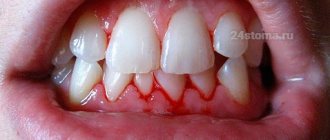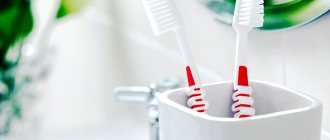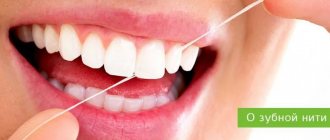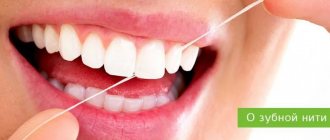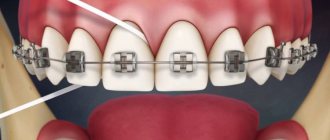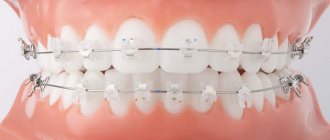When cleaning your mouth, you need to use not only a toothbrush, but also dental floss and toothpicks. Waxed and unwaxed dental floss help clean the hardest to reach areas. There are two types of dental floss: waxed and unwaxed. In this article we will look at how effective dental floss is and which one is better to choose.
First of all, dental floss is an effective means of cleaning food and plaque from your mouth. It allows you to clean places that are inaccessible to a toothbrush and even toothpicks, namely the space between the teeth. There are different types of dental floss, some of them are scented. This was done in order to replace the not very healthy thing that people are used to using after eating - mint chewing gum.
Waxed and unwaxed dental floss: what's the difference?
Before purchasing dental floss, you need to familiarize yourself with their types:
- Waxed dental floss is coated with wax for better glide between teeth and to reduce pain or simply unpleasant sensations that arise during the process of cleaning the oral cavity. This floss is suitable for people with no gaps between their teeth, for those whose teeth are close to each other.
- Unwaxed dental floss is not coated with wax, so it cleans between teeth much better. This allows it to be more economical and useful to use. It is ideal for people with loose teeth. This thread is stratified into several layers of hairs, which more effectively remove pieces of food.
In addition, dental floss can be round or flat. The round one is suitable for people with wide interdental openings, and the flat one is for those who have narrow or almost absent openings. There are also so-called “superfluxes”, they have both round and flat areas. This allows you to regulate the process of cleaning the interdental space. Such threads are more difficult to find than regular ones, and they cost much more. But there are much more benefits and convenience from them.
Pros and cons of unwaxed thread
Fibers that do not have a wax coating, penetrating into the spaces between the crowns, bifurcate and absorb more plaque. This happens because their absorption capacity increases and they capture a larger surface of the organ. If the patient suffers from crowded teeth, it is recommended that he use flat fibers. Due to their slight thickness, they will penetrate even into tight spaces. The round cross-section of the floss is suitable for caring for wide intermediate spaces. The increased volume of fiber makes it possible to reach the side zones and clean them efficiently.
If the dirt is old and dense, it is better to remove dental plaque in the dentist’s office. The doctor will determine which technology to use for cleaning. The characteristics of the oral cavity, concomitant diseases, and the degree of contamination will be taken into account. It is important to choose an experienced hygienist and a modern clinic with new equipment.
Pros and cons of using dental floss
Waxed and unwaxed dental floss, like everything else, has both positive and negative sides. Undoubtedly, there are still more advantages, but it is worth paying attention to the disadvantages of using dental floss.
The positive aspects are the ability to clean the tooth surface at any time, this is especially useful when it is not possible to use a toothbrush and toothpaste. In addition, dental floss can penetrate into places where a toothbrush and toothpicks cannot reach - into the interdental space. To use floss you don't need any rules or special skills, it's easy to use, and the small box can fit anywhere - from a pocket to a wallet. You can buy dental floss at almost any pharmacy. It is better to use floss after eating, when there is a high probability of food debris accumulating between the teeth.
Now it’s worth noting the negative aspects of using dental floss. First of all, there is always a risk of damaging the gums with an awkward movement, which will cause bleeding and the risk of inflammation or infection. And flossing too often can damage or destroy tooth enamel. This can lead to a number of problems, such as tooth decay. In addition, when using waxed thread, you may develop an allergy to its constituent components, primarily wax.
The thread itself cannot cause any harm; the cause of gum injuries usually lies in careless use of the thread: too sharp jerks or strong pressure. Also, don't floss too often.
Which is better?
Many people ask themselves, “Which dental floss is better: waxed or unwaxed?” This is not a completely correct question, because the selection of floss should be done by a specialist who can assess the “patency” of your interdental spaces and determine the best option. Moreover, in his office you must make sure there are no contraindications. Dental floss can also be harmful if a person is not prepared to use it.
Obviously, you need to start with waxed thread - it is less difficult to use, more pleasant to the touch and gives “consolation prizes” to beginners - tasty impregnations. But unwaxed brushes your teeth better, but requires certain skills and remarkable caution from you. If you do not learn how to handle it correctly, the transition can have a detrimental effect on the health of your gums. There will be no end to the cuts, as well as the negativity towards the whole procedure as a whole.
If you want to learn more about modern oral hygiene, check out our review of the latest gadgets for more effective teeth cleaning. Maybe that's where you'll find a more suitable option.
Tags: waxed floss, dental floss, unwaxed floss, review, floss
About the author: DrZubastik
- Related Posts
- Have your teeth whitened? Let's follow the white diet!
- Why get temporary crowns?
- What not to do after tooth extraction: 10 anti-tips
« Previous entry
Waxed and unwaxed dental floss: which is better?
When choosing dental floss, it is worth remembering the wax content of waxed floss. Despite its low wax content, it may not be suitable for people who are allergic to it. In addition, waxed floss is treated not only with wax, but also with other special sliding substances that give teeth a pleasant minty smell or improve the quality of tooth enamel.
Also, when choosing a thread, you need to pay attention to the quality of the product, the strength and quality of the packaging. Then you should pay attention to the manufacturer and, if desired, study reviews on the Internet. This will help you choose the best and most proven option.
At the same time, it is worth paying attention to the materials from which the thread is made. It is best to choose a thread that uses natural materials: silk thread and real wax. This material, among other things, is also very strong. However, this option is not suitable for allergy sufferers, since natural ingredients can provoke an attack of the disease. In this case, it is better to pay attention to dental floss made of nylon or nylon.
Comments
Yeah, you can also use a church candle (thin yellow one), it’s also made of wax. It takes a very long time. I bought it in the summer, now it’s already spring - and it doesn’t seem to be getting any smaller. For convenience, I warmed the candle very well with my hands and kneaded it so that I could get the wick out, and then rolled it into a cube. And I use it.
The church sells candles that are not made of 100% wax. There the content of impurities (such as paraffin, ceresin, etc.) is at least 30% or even more. Natural wax can be found in honey shops.
Well, I don't know. At least the thread does not get tangled or twisted as often as if it had not been waxed at all.
Thanks for the info.
They also sell wax in special cases in handicraft departments. Convenient too. You can also buy the so-called. zabrus These are wax caps cut from honeycombs before squeezing. There is honey and all sorts of healthy yummy stuff there. You chew everything, then put the chews in a cup of water and melt them in the microwave. The wax is distributed in a thin plate over the surface of the water. After cooling, clean the underside of the record from any debris that was in the wax. Repeat the procedure until completely cleansed. Usually this is five or six times. I always feel sorry for throwing away chewed wax after honeycombs. Then you can pour it into any form convenient for you and use it at your discretion.
Process. I do it a little differently, I run natural wax along the thread and immediately run it (the thread) with a soft cloth, which I hold near the lamp.
How interesting! Live and learn! Thanks for the necessary information
https://biser.info/node/20807 There were several such topics on the site. This is one of them.
Thanks for the link, but I wrote about something else if you looked at my link. It’s not about waxing or not waxing, but how to wax.
Just in the link I gave, there are a lot of tips on HOW TO WAX! Apparently you didn't even bother to read!
You wrote rather rudely, in my opinion. According to the link you gave, there is no such method of waxing as Manisha suggests. Believe me, I was not too lazy to read the blog.
Flossing
In fact, there are no special rules for using dental floss, however, there is a list of tips and tricks.
First of all, it is necessary to use dental floss after each meal to more effectively clean the mouth. This must be done extremely carefully so as not to damage the gums and tooth enamel. If traces of blood appear on the surface of the thread, the procedure must be stopped. It is also necessary to stop if painful sensations occur. Sequence of brushing teeth with dental floss:
- To begin with, you should unwind a small piece of dental floss about four to five centimeters long. This length is the most optimal for holding the thread tightly and sliding well over the surface of the teeth.
- Next, you need to wrap the ends of the thread around your index fingers so that the thread does not fall off, but does not pinch them too tightly. The thread must be tensioned.
- Lightly, without sudden movements, you need to press on the area between the teeth so that the thread goes in all the way. Cleaning should be done with the same light, “sawing” movements.
Differences
Waxed floss is a smooth, wax-impregnated floss that is usually recommended for beginners. As a rule, it is soaked in an antiseptic solution and has a pleasant taste. Due to its properties, it passes between the teeth much more easily. It is more difficult for them to injure the gums, it is easier to use, so for children and those who have never purchased dental floss, it is better to start with this type.
Unwaxed thread is a tougher and more dangerous hygienic find. During the process of brushing your teeth, it is divided into several smaller threads and covers a larger area. Due to the hardness of the fibers, it removes plaque much more effectively, but it can easily damage the gums. This thread is not impregnated and is suitable even for allergy sufferers. It is worth switching to it for those people who have already mastered the correct use of floss.
Advantages and disadvantages of waxed thread
Let's look at the positive and negative aspects of using impregnated floss.
The fact that the floss glides more easily and penetrates into the narrowest spaces between teeth allows dentists to recommend it to children and adult patients who do not have flossing skills. Wax and other impregnation components give the surface of the fibers smoothness. This reduces the likelihood of cutting your gums after an accidental, careless movement.
Another advantage is that quite often the manufacturer adds sodium fluoride and menthol to the impregnation composition. The first component helps prevent caries. Menthol helps freshen breath.
Also, do not forget that waxed threads have good strength - they do not break during the hygiene procedure.
How to use thread
Dentists recommend starting to floss at the age of 10, but children need to do this under adult supervision. If you decide to use it at an older age, still consult your doctor first. When using dental floss for the first time, a number of difficulties may arise. But this is a temporary phenomenon, very soon you will get used to it and notice the first improvements in your teeth.
Here is an approximate sequence of actions:
- Unwind 50–60 mm of thread.
- Cut it with a knife, which is located in the upper section of the case.
- The floss is wound around the index fingers of both hands. After this, insert it between the teeth, you should get a structure resembling the letter C.
- Start moving the floss back and forth and up and down.
- Be careful when the thread comes into contact with the gum so as not to damage it.
The video shows how to properly use dental floss:
Whether or not to floss is up to everyone. But it has been scientifically proven that people who floss are less likely to develop dental problems. If you brush between your teeth after every meal, you are unlikely to suffer from oral diseases.
The article was prepared under the editorship of doctors - dental implantation center ICDI ROOTT
Types of impregnation for waxed/unwaxed thread
To increase the positive qualities of floss, aesthetic and hygienic, manufacturers impregnate them with additional products, which are divided into several types.
- Aromatic impregnation. Such threads contain fragrances with the smell of mint, menthol or fruit. Gives freshness to breath. Often the cause of bad breath is food that is not cleaned from the interdental spaces with a toothbrush.
- Fluorine solution. This type of impregnation is not suitable for everyone, but only for those who need additional fluoridation of tooth enamel. Strengthens and nourishes hard tissues.
- Disinfectant impregnation, for example, chlorhexidine. Destroys pathogenic bacteria in the oral cavity.
Fluoride and chlorhexidine impregnations serve as a softening agent for unwaxed thread. This makes it glide easier and look more like floss soaked in wax.
Reference! The waxed look often has an aromatic impregnation.
Waxing thread
How a fine fellow would have a patterned caftan, Morocco boots with red trim, A fly-fly camlet on ports, People would admire the fine fellow.
I wax like this: I wind a thread around a stick to make a spool. I melt the beeswax in a bowl on the stove, and when it bubbles a little, I throw the coil in there and let it soak in the wax thoroughly. I take the coil out of the still melted hot wax and let it cool. After which it is very convenient to unwind the already wired thread. All excess wax comes off when unwinding.
Thanks, I tried it, it's a good method.
I propose a method developed by me, here is the diagram:
I use 2 corrugated baking pans. These are sold in Auchan or can be kept somewhere by your mother or grandmother since Soviet times. We put a frying pan on the stove, which is not too small, or a tin can (so that the wax does not drip into the stove), put the first mold on it, put a piece of wax in it, turn on the stove on a small fire, wait for the wax to completely melt. Take a spool of thread ( straight from a magazine spool, no need to unwind anything) and tie the end of the thread to some kind of rod (I use an old ballpoint pen), unwind the thread a little. When the wax has melted, we put this unwound piece of thread into the wax so that the thread goes straight through the center of the mold, that is, the thread must exit the mold through the corrugation opposite the one through which it enters, otherwise the thread will fly out of the mold. Next, we place another mold on top: the corrugations provide adhesion between the forms and it turns out that the thread enters and exits through a kind of channel formed by two forms, i.e. it will not fly out anywhere. Place a weight on top of the molds. I used an old small iron and a bronze candlestick stand. The weight should press so as to prevent the thread from pushing out the top mold and so that the molds do not move with the thread, but at the same time it should not press so hard that the thread gets stuck and does not stretch. Now we begin to slowly pull the thread, unwinding it from the spool and winding it around the rod. That. The thread, passing between the forms, is wired very well. Moreover, after waxing, such a thread does not need to be heated or anything else done to it. You can sew right away. In addition, using this method you can quickly, within a couple of minutes, thread the required amount of thread.
As a child I played with construction sets, and now I'm a reenactor
Faith in God saves the souls of many people, and faith in the historicity of quilts and stuffing saves the bodies of many reenactors
Source


